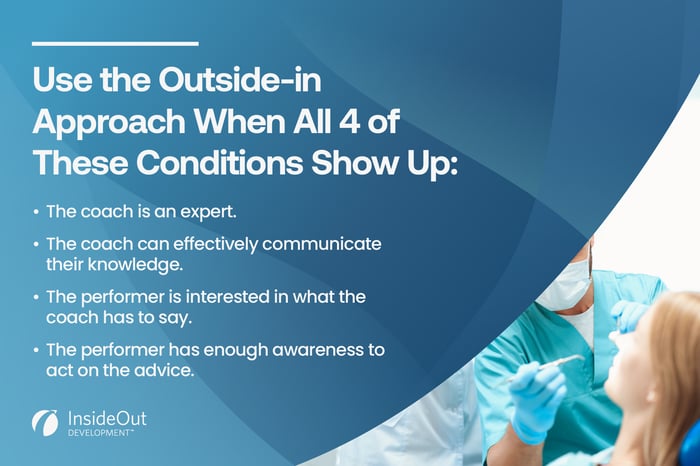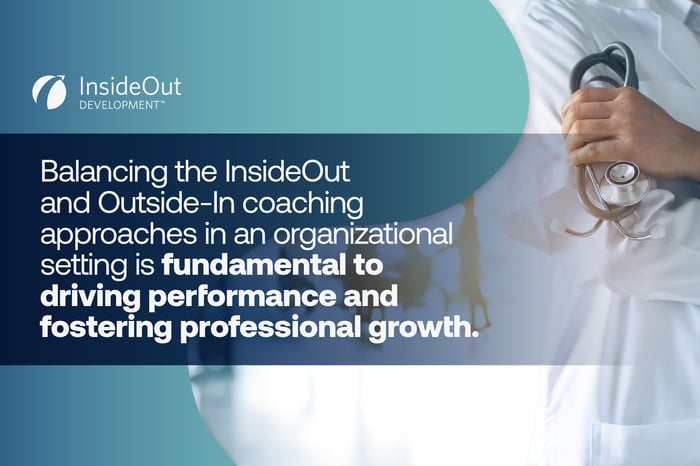The InsideOut coaching approach is essential to maximizing performance and driving long-term success. It’s the best way to help individuals take ownership of action plans and key results. It’s founded on the belief that everyone has the capacity to learn and perform at a higher level.
This InsideOut Approach™ — or the “ask” approach” — removes interference so individuals can learn faster and act on existing knowledge to solve complex problems and build ownership.
It asks “What can I bring out of this individual to help them perform better?” It operates in the belief that people already know what they need to know to do a task, but something is preventing them from doing it.
But there are times when the Outside-In approach — or the “telling” or “advice-giving” approach — works best.
What Is an Outside-In Approach?
 The Outside-In approach asks “What can I put in to give this person the answers they need to succeed?” It operates in the belief that this person would be able to do the task if they just had a key piece of information.
The Outside-In approach asks “What can I put in to give this person the answers they need to succeed?” It operates in the belief that this person would be able to do the task if they just had a key piece of information.
It’s essential when you need to give urgent direction or explain complex policies that must be followed for purposes of safety, liability, or consistency.
4 Times to Consider Using an Outside-In Approach
Use the Outside-In approach when all four* of these conditions show up:
- The coach is an expert.
- The coach can effectively communicate their knowledge.
- The performer is interested in what the coach has to say.
- The performer has enough awareness to act on the advice.
*If even one of these elements is missing, you’ll find an InsideOut Mindset more effective at driving behavior change.
1. The Coach Is an Expert
Managers are often promoted because they’re great at what they do. Still, that doesn’t mean they’re good at inspiring that greatness in others.
If the manager or coach really is an expert in their field, then they probably have some key advice to help others step up to the plate. But beware of imposter syndrome. Often managers think they need to be the expert — that they need to know everything.
Great managers know they don’t need to be the expert on every subject. But they do recognize when they don’t know the answer. It’s okay not to know the answer, but if you do know the answer, then the Outside-In approach may work for you.
However, if the coach is not truly an expert, the “advice” they give could be bad, incorrect, or counterproductive. In these cases, the InsideOut Approach™ helps managers and employees solve problems together.
2. The Coach Can Communicate Their Knowledge
As a coach, being an expert isn’t useful if you can’t communicate your knowledge — and it’s only half the battle of being a great leader. If you can’t effectively communicate what you know, your well-intentioned help may be misconstrued and complicate matters. Instead, communication skills are how you inspire greatness in others.
There are plenty of resources to help people communicate better. We even wrote an eBook on the subject. But even the best communicators can be tripped up by circumstances beyond their control.
General communication best practices are great, but other forms of miscommunication can interfere with a coach’s ability to communicate with a particular individual. Cultural, generational, and individual differences can all impact communication.
Processes and tools play just as critical a role in effective communication as individual communication skills. While this is true of any employee, it’s especially important for remote employees. Make sure your tech stack enhances your communication skills.
3. The Performer Cares About What the Coach Has to Say
Some elements of communication are out of the coach’s control. Like talking a teenager out of a bad boyfriend, if the performer isn’t interested in the coach’s opinion, it will fall on deaf ears.
Many factors can impact a performer’s interest in their manager’s opinion — it’s about more than obstinance. Performers may be unaware of the problem that requires manager intervention. They may think they have the tools and know-how to solve the issue on their own. They may be overwhelmed and overloaded with information and simply can’t process more.
If an employee has taken ownership of a problem or project and a manager forces an unwanted Outside-In approach, they may switch from high-performing ownership to basic accountability.
4. The Performer Has the Awareness to Act on the Advice
If a performer is so overwhelmed by a project, or completely unaware of a problem, it may not be a problem of interest, but of awareness and ability to act.
If you share your well-intentioned, well-articulated, and well-warranted idea, will the employee be able to act on the information? Or will it leave them more overwhelmed or confused with yet another inaccessible “Way Forward”?
If a performer is unaware of a problem or unaware of the impact the problem is having on others, then it’s time for an alignment conversation. These conversations realign expectations and objectives between employees and organizations.
An alignment conversation takes an InsideOut Approach™ to generating awareness of a problem, identifying the root of the problem, and agreeing on an actionable Way Forward.
On the other hand, if the performer comes to the coach, in their role as an expert, trusting in their ability to solve the problem, the performer probably has enough awareness of the problem to act on the advice. At this point, an Outside-In approach is the right approach.
Leveraging InsideOut and Outside-In Approaches for Success
Balancing the InsideOut and Outside-In coaching approaches in an organizational setting is fundamental to driving performance and fostering professional growth.
While the InsideOut Approach™ champions self-discovery, ownership, and problem-solving capacity within individuals, the Outside-In methodology offers expert guidance and immediate solutions where necessary. Striking the right balance between these approaches ensures a dynamic coaching environment that fosters growth and efficacy within the organization.
Learn more about the InsideOut difference here.





